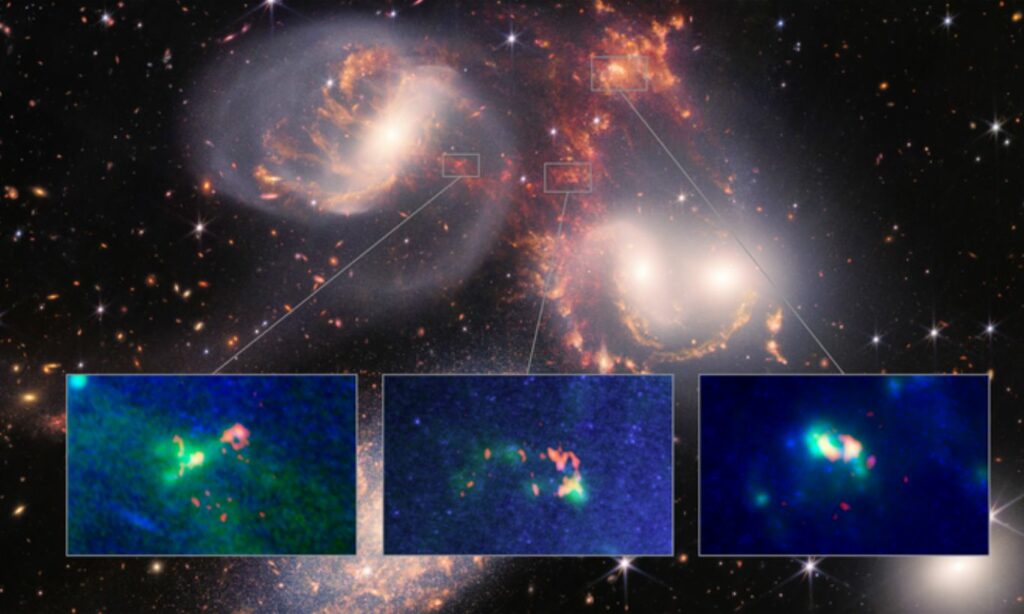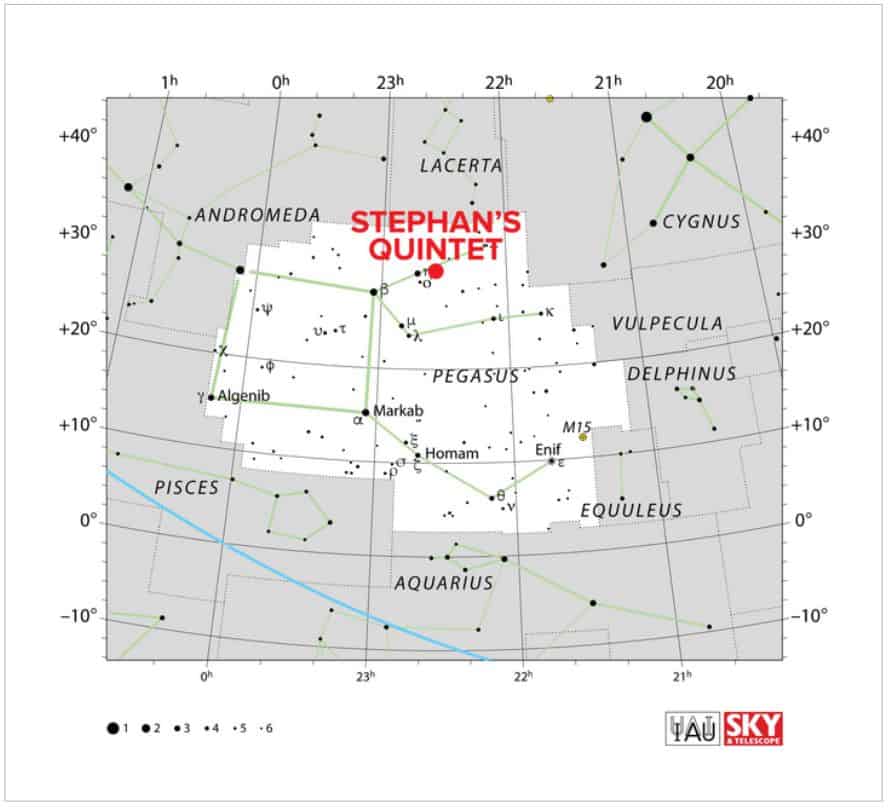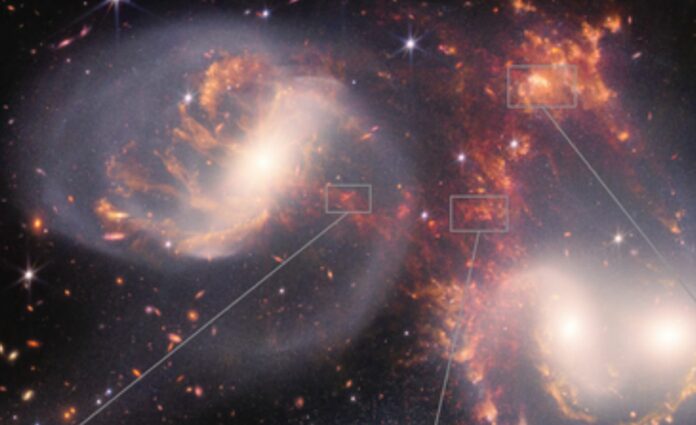New observations witnessed never seen before strange activities resulting from a violent collision between an Intruder Galaxy and Stephan’s Quintet – located about 270 million light-years from Earth in the constellation Pegasus.
New observations made with the James Webb Space Telescope (JWST) and the Atacama Large Millimeter/submillimeter Array (ALMA) have shown that a sonic boom many times the size of the Milky Way has ignited a recycling factory for warm and cold molecular hydrogen gas.
In addition, researchers discovered the breakup of a massive cloud into a warm gaseous fog, the potential collision of two clouds into a warm gaseous splash, and the birth of a new galaxy.
The findings were announced today during a press conference at the American Astronomical Society’s (AAS) 241st meeting in Seattle, Washington.
NGC 7317, NGC 7318a, NGC 7318b, NGC 7319, and NGC 7320 are the five galaxies that make up Stephan’s Quintet. They are all around 270 million light-years away from Earth in the constellation Pegasus.
The group constitutes a pure laboratory in which to investigate the effects of galaxy collisions on their surroundings. Stephan’s Quintet does not experience the typical surge of star creation brought on by galaxy mergers and collisions.
Instead, these catastrophic events are happening in the intergalactic medium, far from galaxies and in regions with little star formation.
Astronomers have been able to watch what’s going on as one of the galaxies, NGC 7318b, crashes into the group with a relative speed of about 800 km/s.
At that speed, it would only take eight minutes to get from Earth to the Moon.
Philip Appleton, an astronomer and senior scientist at Caltech’s Infrared Processing and Analysis Center (IPAC) and the project’s principal investigator, noted, “As this intruder crashes into the group, it is colliding with an old gas streamer that likely was caused by a previous interaction between two of the other galaxies, and is causing a giant shockwave to form.”
As the shockwave travels through this clumpy streamer, it generates a very turbulent, or unsteady, cooling layer. In locations impacted by this violent activity, they obeserved unexpected formations and the recycling of molecular hydrogen gas. Understanding the destiny of molecular hydrogen will help us learn more about the development of Stephan’s Quintet and galaxies in general since it serves as the building block for stars.
The National Radio Astronomy Observatory (NRAO) of the United States, which developed ALMA’s Band 6 (1.3 mm wavelength) receiver, enabled researchers to zoom into three key regions in incredibly fine detail and, for the first time, click a clear picture of how the hydrogen gas is moving and changing over time.
According to Joe Pesce, Program Officer for ALMA at the U.S. National Science Foundation, “the power of ALMA is obvious in these observations, providing astronomers new insights and better understanding of these previously unknown processes”.
The area at the center of the primary shock wave, known as Field 6, showed a massive cloud of cold molecules that is continually cycling through these identical phases before being split up and extended out into a long tail of warm molecular hydrogen.

“What we’re seeing is the disintegration of a giant cloud of cold molecules in super-hot gas, and interestingly, the gas doesn’t survive the shock, it just cycles through warm and cold phases,” Appleton added. “We don’t yet fully understand these cycles, but we know the gas is being recycled because the length of the tail is longer than the time it takes for the clouds it is made from to be destroyed.”
The shockwaves have caused more strange things than just this intergalactic recycling plant. In the area called Field 5, scientists saw a stream of warm molecular hydrogen gas connecting two cold gas clouds.
Unexpectedly, one of the clouds—which resembled a cold hydrogen gas bullet traveling at great speed colliding with a wide filament of gas stretched out—punched through the structure and left behind a ring.
This collision is supplying energy to the warm envelope of gas around the location, but scientists are uncertain as to what this signifies since they lack extensive observational data for the warm gas.
As explained by co-investigatorBjorn Emonts: “A molecular cloud piercing through intergalactic gas, and leaving havoc in its wake, may be rare and not yet fully understood. But our data show that we have taken the next step in understanding the shocking behavior and turbulent life-cycle of molecular gas clouds in Stephan’s Quintet.”
The location known as Field 4 may be the most “normal” of the group, where researchers discovered a calmer, less chaotic environment that let hydrogen gas to compress into a disk of stars and what they think is a compact dwarf galaxy in development.
According to Pierre Guillard, a co-investigator on the project, “In field 4, it is likely that pre-existing large clouds of dense gas have become unstable because of the shock, and have collapsed to form new stars as we expect.”
He added that all of the new observations have significant implications for theoretical models of the impact of turbulence in the Universe.
“The shock wave in the intergalactic medium of Stephan’s Quintet has formed as much cold molecular gas as we have in our own Milky Way, and yet, it forms stars at a much slower rate than expected. Understanding why this material is sterile is a real challenge for theorists. Additional work is needed to understand the role of high levels of turbulence and efficient mixing between the cold and hot gas.”
Before ALMA’s observations, scientists didn’t know that all of this was happening in the Quintet’s intergalactic medium, but they did try.
In 2010, the team looked at Stephan’s Quintet with the Spitzer Space Telescope and found large clouds of warm molecular hydrogen mixed in with the super-hot gas. These clouds were estimated to be between 100° and 400° Kelvin, or about -280° to 260° Fahrenheit.
“These clouds should have been destroyed by the large-scale shockwave moving through the group, but weren’t. And we wanted to know, and still want to know, how did they survive?” Appleton added.
For the team to figure out what was going on, they needed more and different technological power and skills. More than a year later, in late 2011, ALMA saw its first light, and early this year, JWST saw its first photos.
Infrared photographs of Stephan’s Quintet and a fascinating, if limited, knowledge of the interactions between the cold, warm molecular, and ionized hydrogen gases in the aftermath of the massive shockwave have been made possible by the combination of these powerful resources.
To learn more about the heated molecular hydrogen gas, the researchers now requires spectroscopic data.
However, Appleton said, “these new observations have given us some answers, but ultimately showed us just how much we don’t yet know.”

“While we now have a better understanding of the gas structures and the role of turbulence in creating and sustaining them, future spectroscopic observations will trace the motions of the gas through the doppler effect, tell us how fast the warm gas is moving, allow us to measure the temperature of the warm gas, and see how the gas is being cooled or warmed by the shockwaves. Essentially, we’ve got one side of the story. Now it’s time to get the other.”
Image Credit: ALMA (ESO/NAOJ/NRAO)/JWST/ P. Appleton (Caltech), B.Saxton (NRAO/AUI/NSF) and IAU/Sky & Telescope
